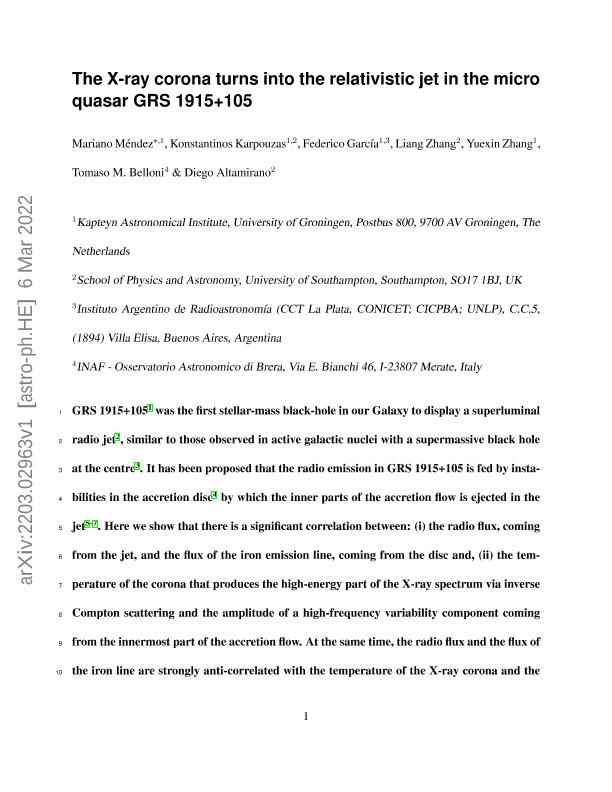Mostrar el registro sencillo del ítem
dc.contributor.author
Méndez, Mariano
dc.contributor.author
Karpouzas, Konstantinos
dc.contributor.author
García, Federico

dc.contributor.author
Zhang, Liang
dc.contributor.author
Zhang, Yuexin
dc.contributor.author
Belloni, Tomaso M.
dc.contributor.author
Altamirano, Diego
dc.date.available
2022-08-08T18:10:01Z
dc.date.issued
2022-03
dc.identifier.citation
Méndez, Mariano; Karpouzas, Konstantinos; García, Federico; Zhang, Liang; Zhang, Yuexin; et al.; Coupling between the accreting corona and the relativistic jet in the microquasar GRS 1915+105; Nature Research; Nature Astronomy; 6; 3-2022; 577–583
dc.identifier.uri
http://hdl.handle.net/11336/164599
dc.description.abstract
Accreting black holes emit highly collimated radio jets expanding at speeds approaching light speed. Some of these jets appear to be expanding at superluminal speeds due to geometric effects. While magnetic fields are thought to be responsible for collimating the ejecta, the mechanism that accelerates the material in these jets remains unexplained. For the galactic black hole GRS 1915+105 with a superluminal radio jet, it has been proposed that thermal instabilities in the accretion disk lead to the ejection of the inner parts of the disk into the jet. Here we use X-ray and radio observations over a 10-year period to reveal a strong correlation between (i) the radio flux that comes from the jet and the flux of the iron emission line that comes from the disk and (ii) the temperature of the hard X-ray corona and the amplitude of a high-frequency variability component that comes from the innermost part of the accretion flow. At the same time, the radio flux and the flux of the iron line are strongly anti-correlated with the temperature of the X-ray corona and the amplitude of the high-frequency variability component. Our findings show that the energy that powers this black hole system can be directed in different proportions either mainly to the X-ray corona or to the jet. These facts, plus our modelling of the variability in this source, suggest that in GRS 1915+105 the X-ray corona turns into the jet.
dc.format
application/pdf
dc.language.iso
eng
dc.publisher
Nature Research
dc.rights
info:eu-repo/semantics/openAccess
dc.rights.uri
https://creativecommons.org/licenses/by-nc-sa/2.5/ar/
dc.subject
X-rays: individual: GRS 1915+105
dc.subject.classification
Astronomía

dc.subject.classification
Ciencias Físicas

dc.subject.classification
CIENCIAS NATURALES Y EXACTAS

dc.title
Coupling between the accreting corona and the relativistic jet in the microquasar GRS 1915+105
dc.type
info:eu-repo/semantics/article
dc.type
info:ar-repo/semantics/artículo
dc.type
info:eu-repo/semantics/publishedVersion
dc.date.updated
2022-07-04T19:40:29Z
dc.identifier.eissn
2397-3366
dc.journal.number
6
dc.journal.pagination
577–583
dc.journal.pais
Reino Unido

dc.description.fil
Fil: Méndez, Mariano. University of Groningen; Países Bajos
dc.description.fil
Fil: Karpouzas, Konstantinos. University of Groningen; Países Bajos
dc.description.fil
Fil: García, Federico. Provincia de Buenos Aires. Gobernación. Comisión de Investigaciones Científicas. Instituto Argentino de Radioastronomía. Consejo Nacional de Investigaciones Científicas y Técnicas. Centro Científico Tecnológico Conicet - La Plata. Instituto Argentino de Radioastronomía; Argentina. University of Groningen; Países Bajos
dc.description.fil
Fil: Zhang, Liang. University of Southampton; Reino Unido
dc.description.fil
Fil: Zhang, Yuexin. University of Groningen; Países Bajos
dc.description.fil
Fil: Belloni, Tomaso M.. Osservatorio Astronomico Di Brera; Italia
dc.description.fil
Fil: Altamirano, Diego. University of Southampton; Reino Unido
dc.journal.title
Nature Astronomy
dc.relation.alternativeid
info:eu-repo/semantics/altIdentifier/doi/http://dx.doi.org/10.1038/s41550-022-01617-y
dc.relation.alternativeid
info:eu-repo/semantics/altIdentifier/url/https://www.nature.com/articles/s41550-022-01617-y
Archivos asociados
